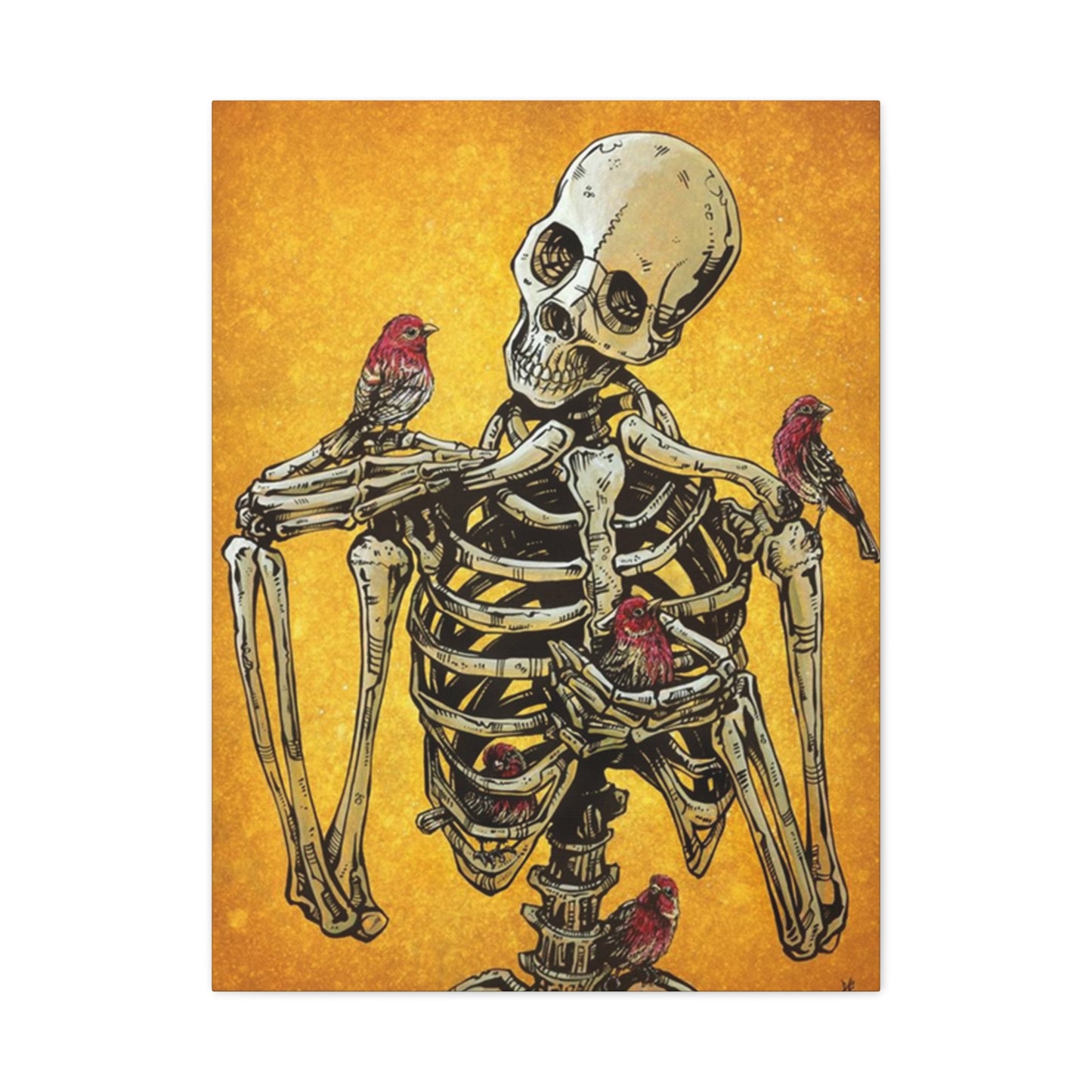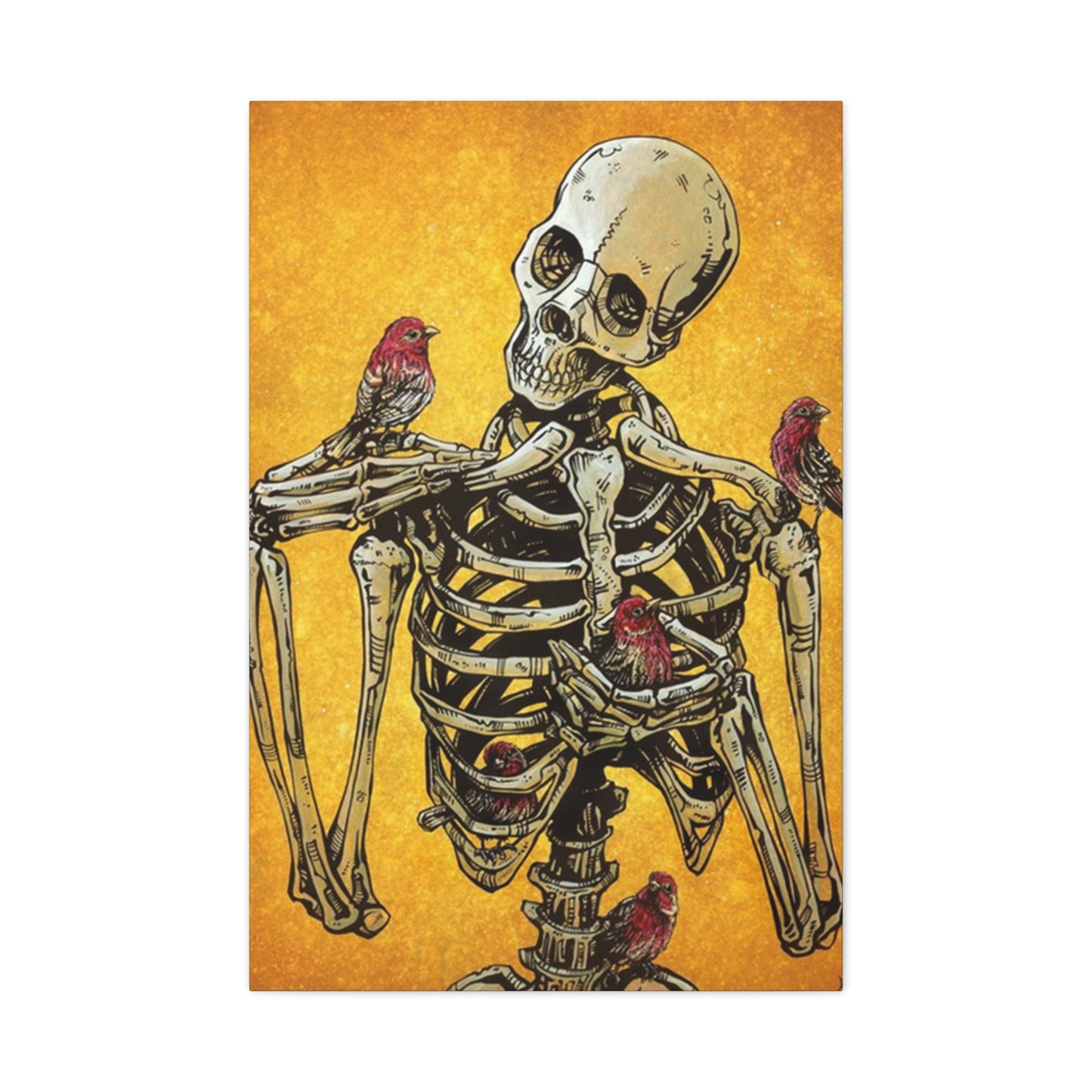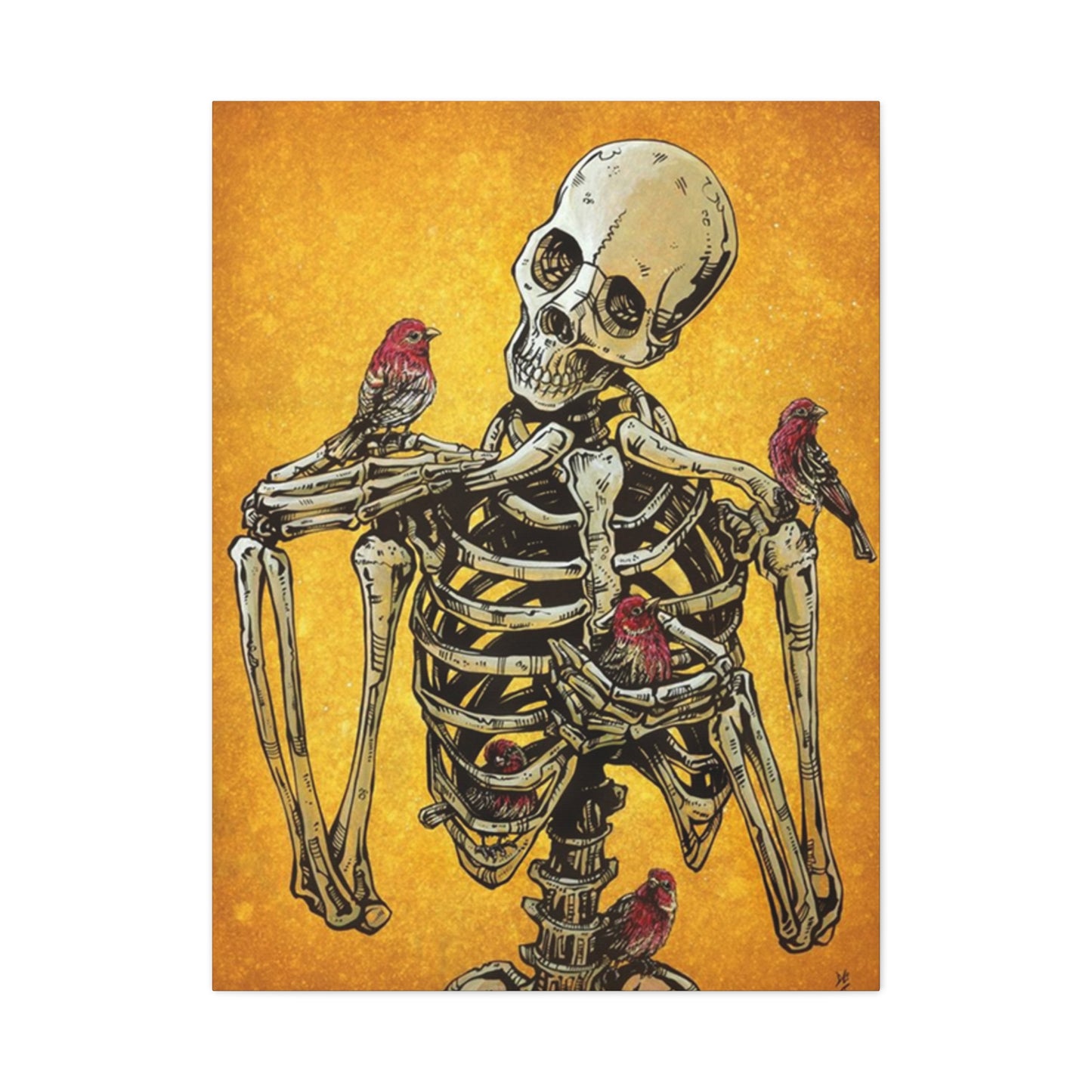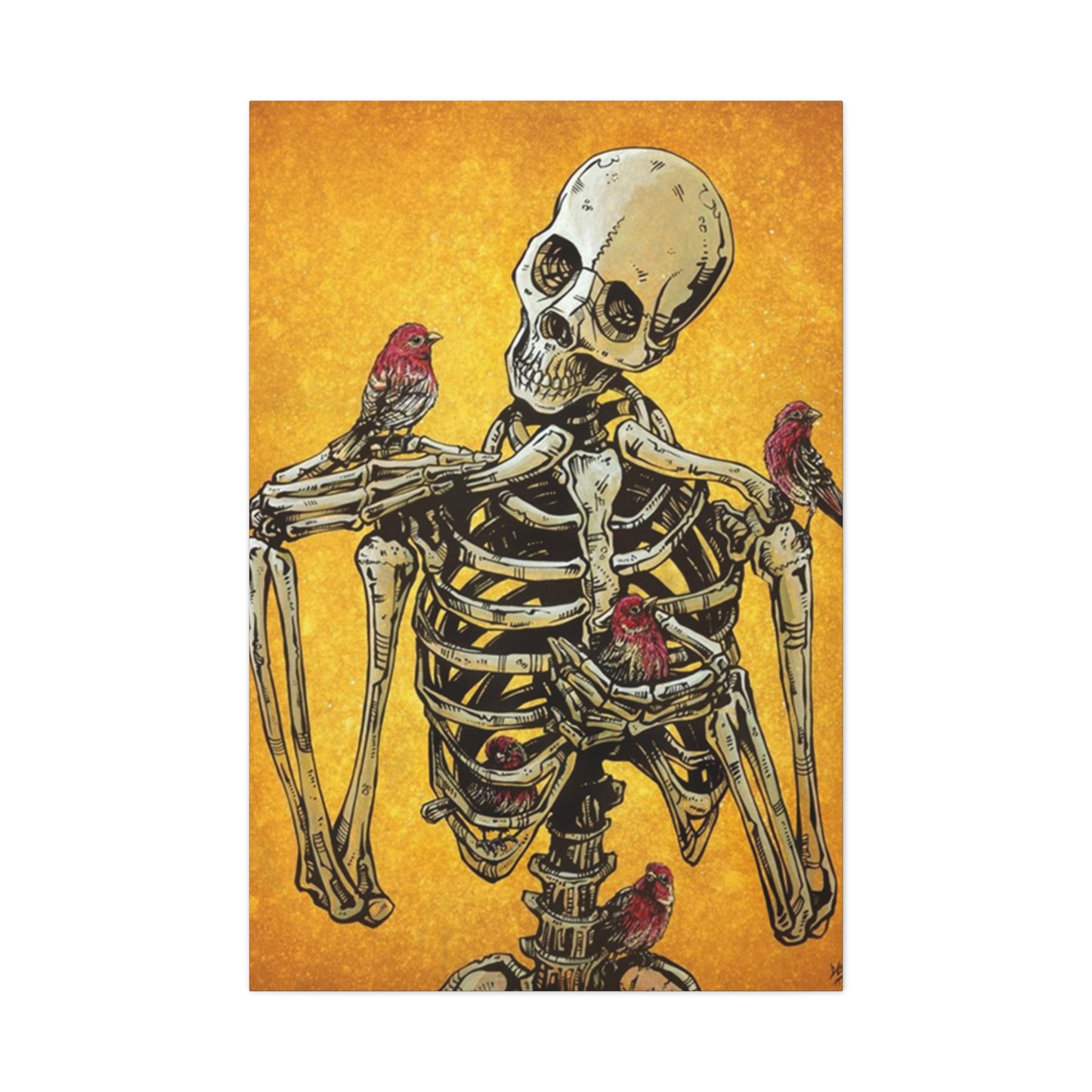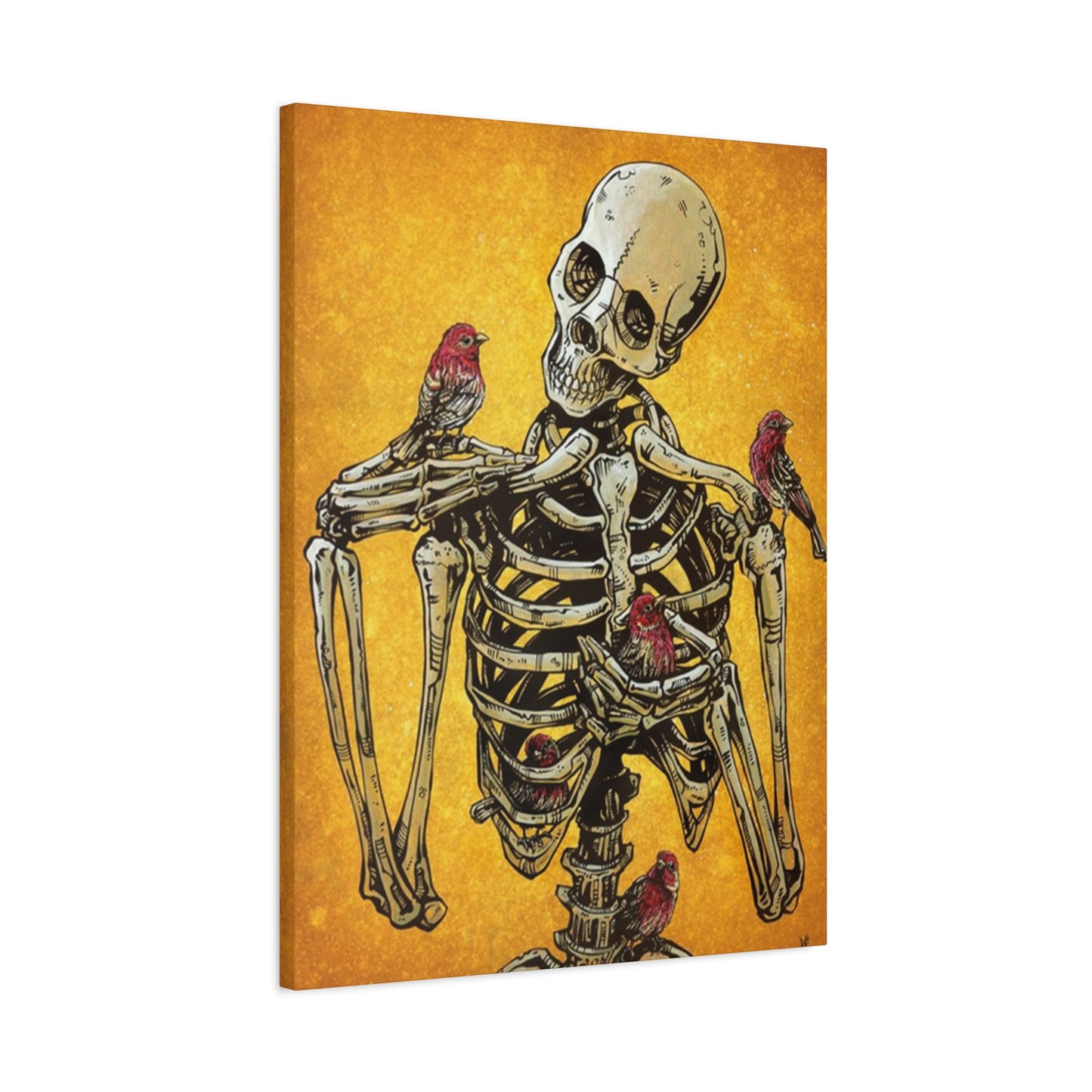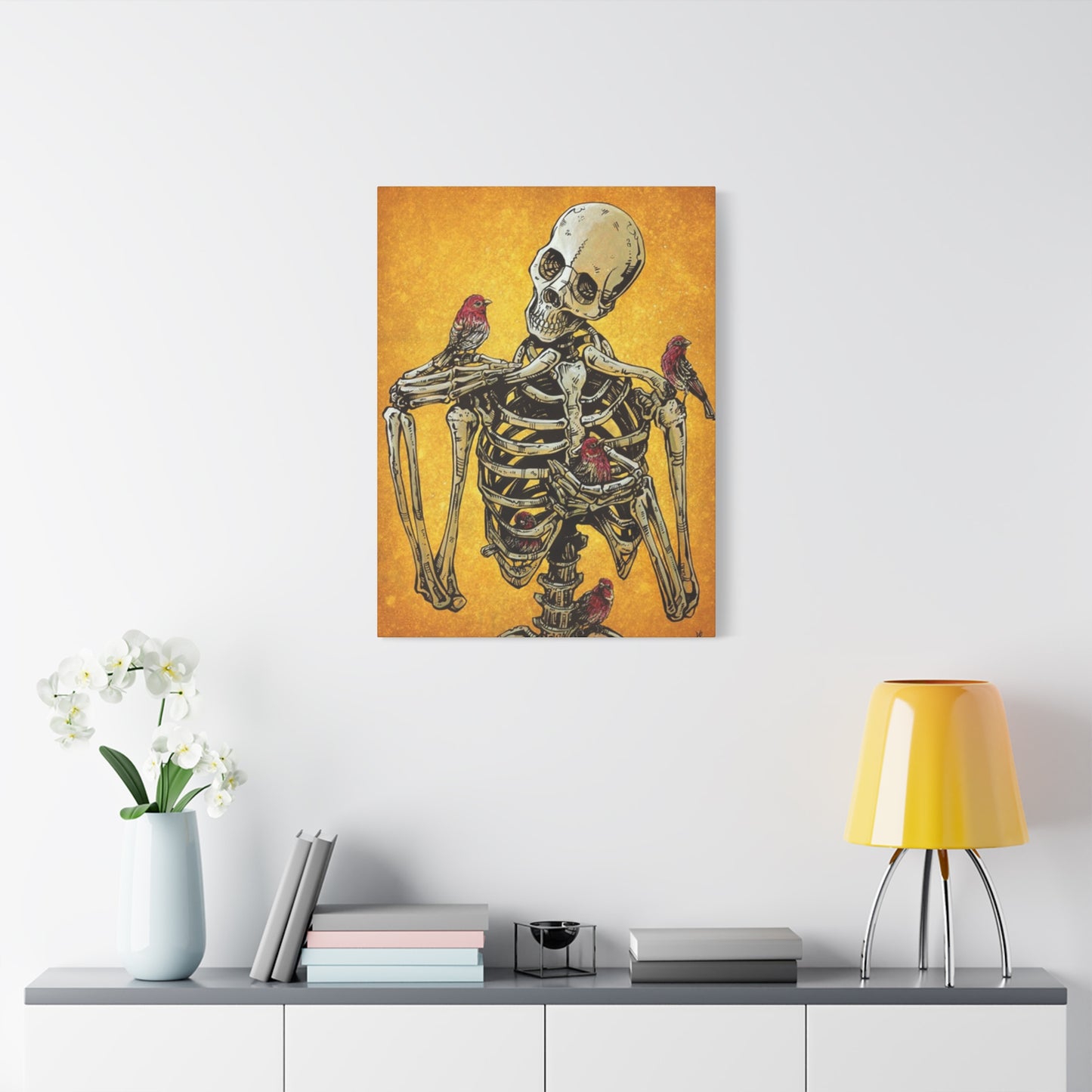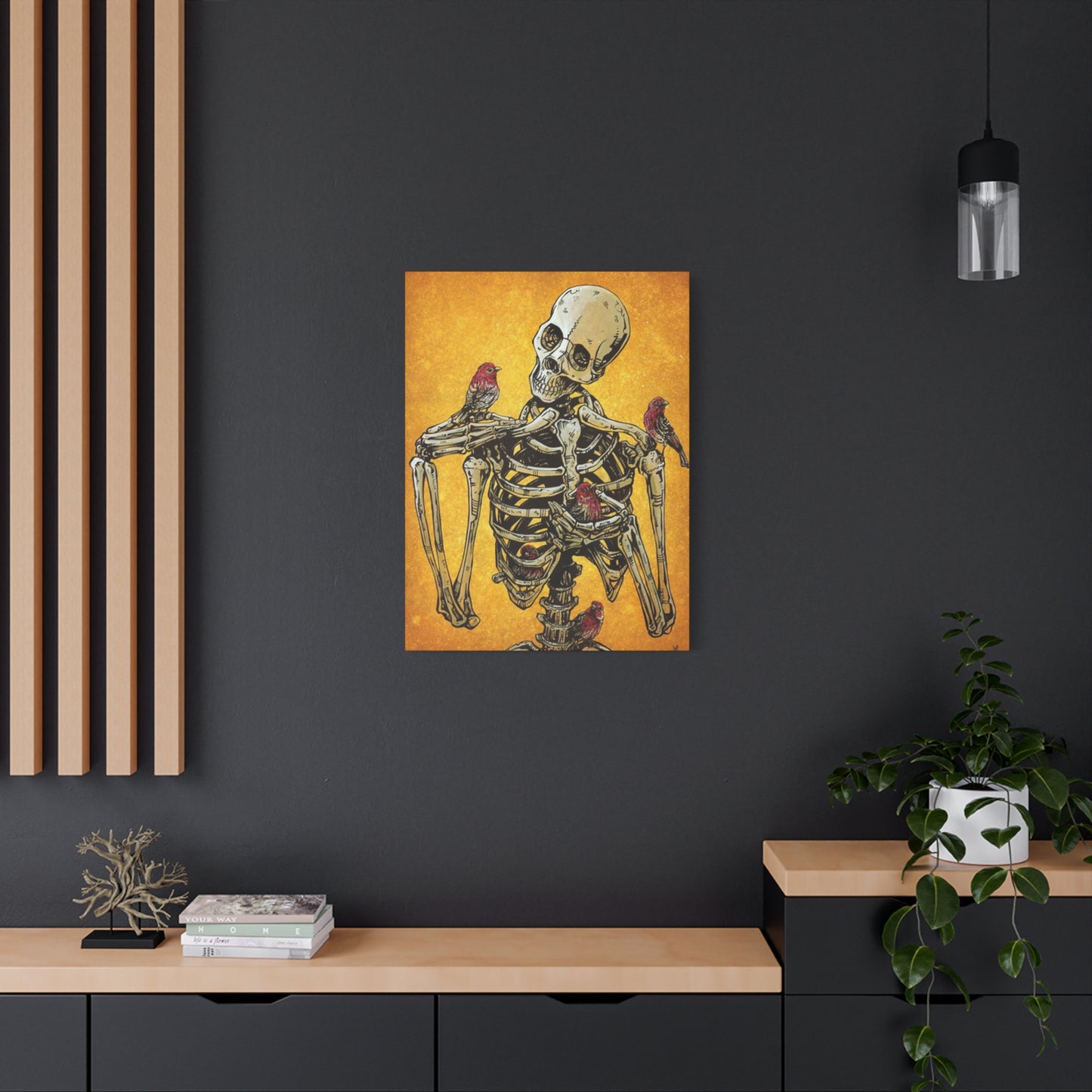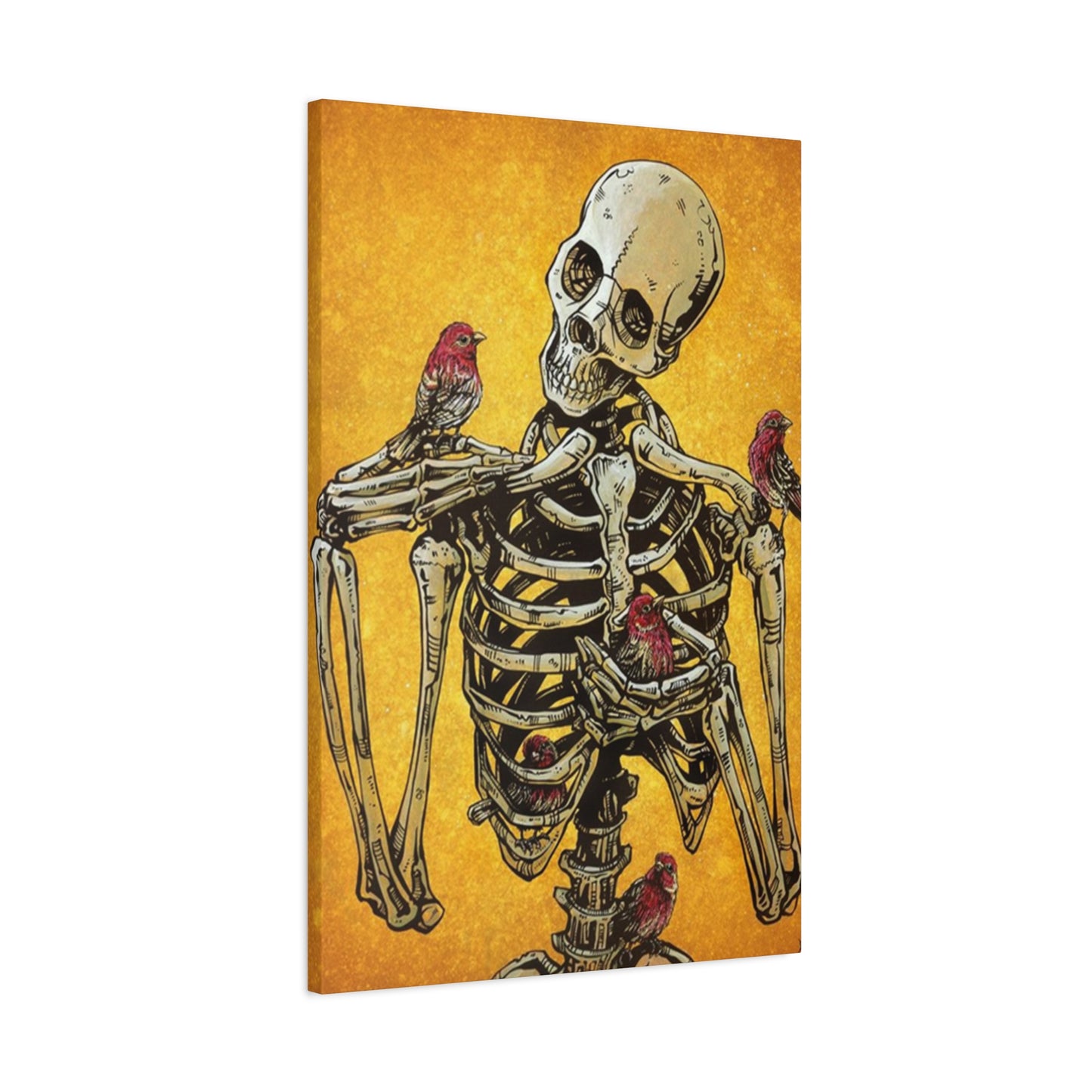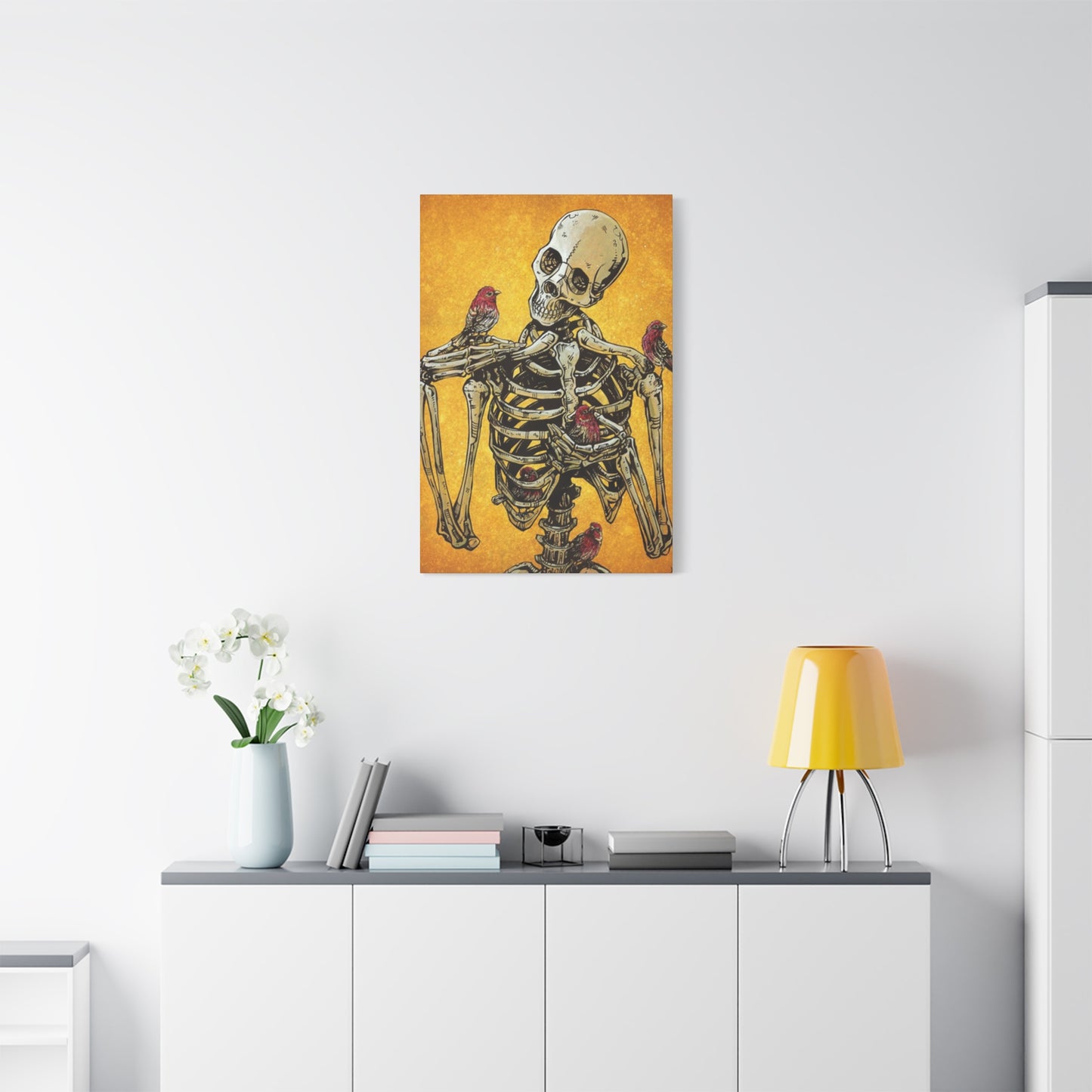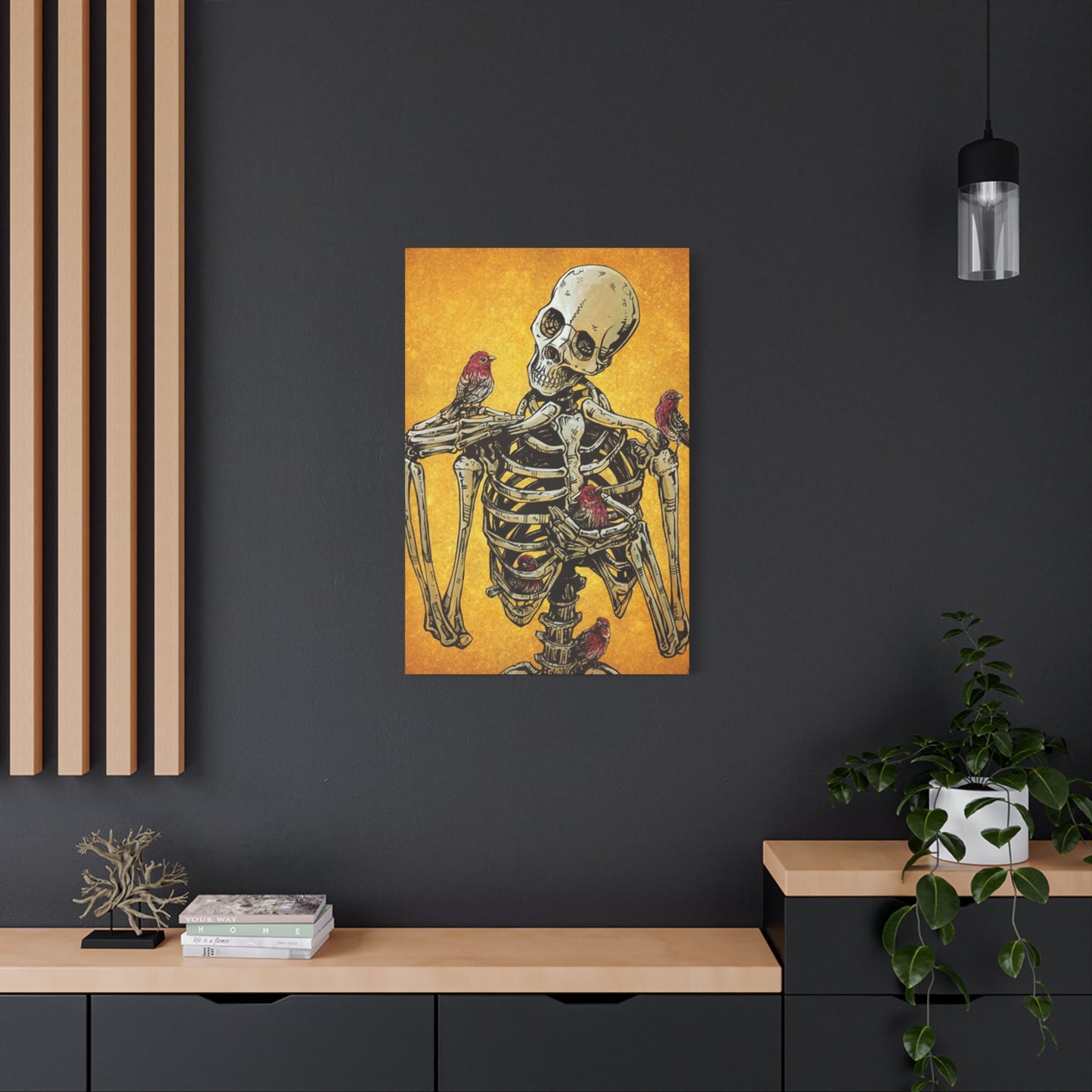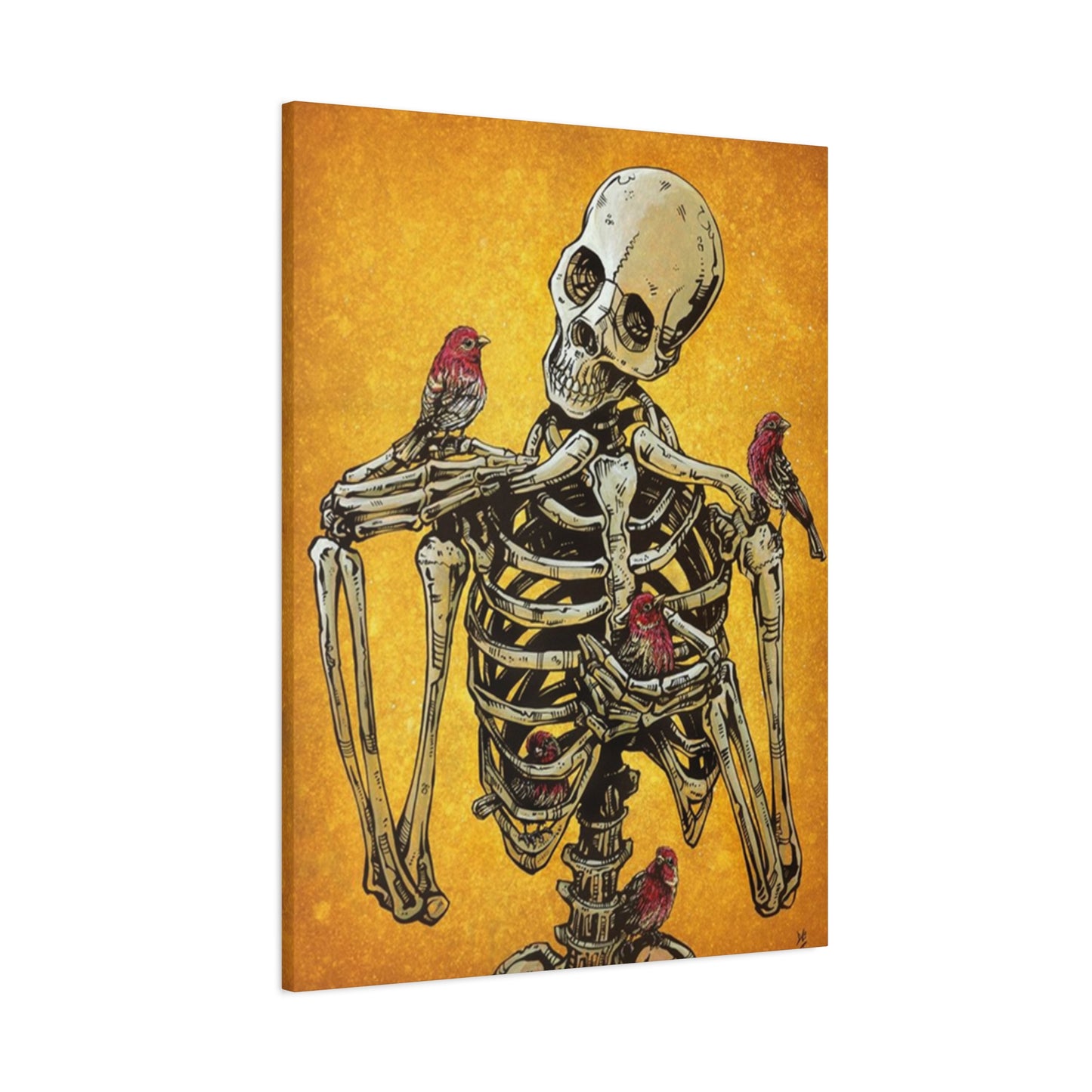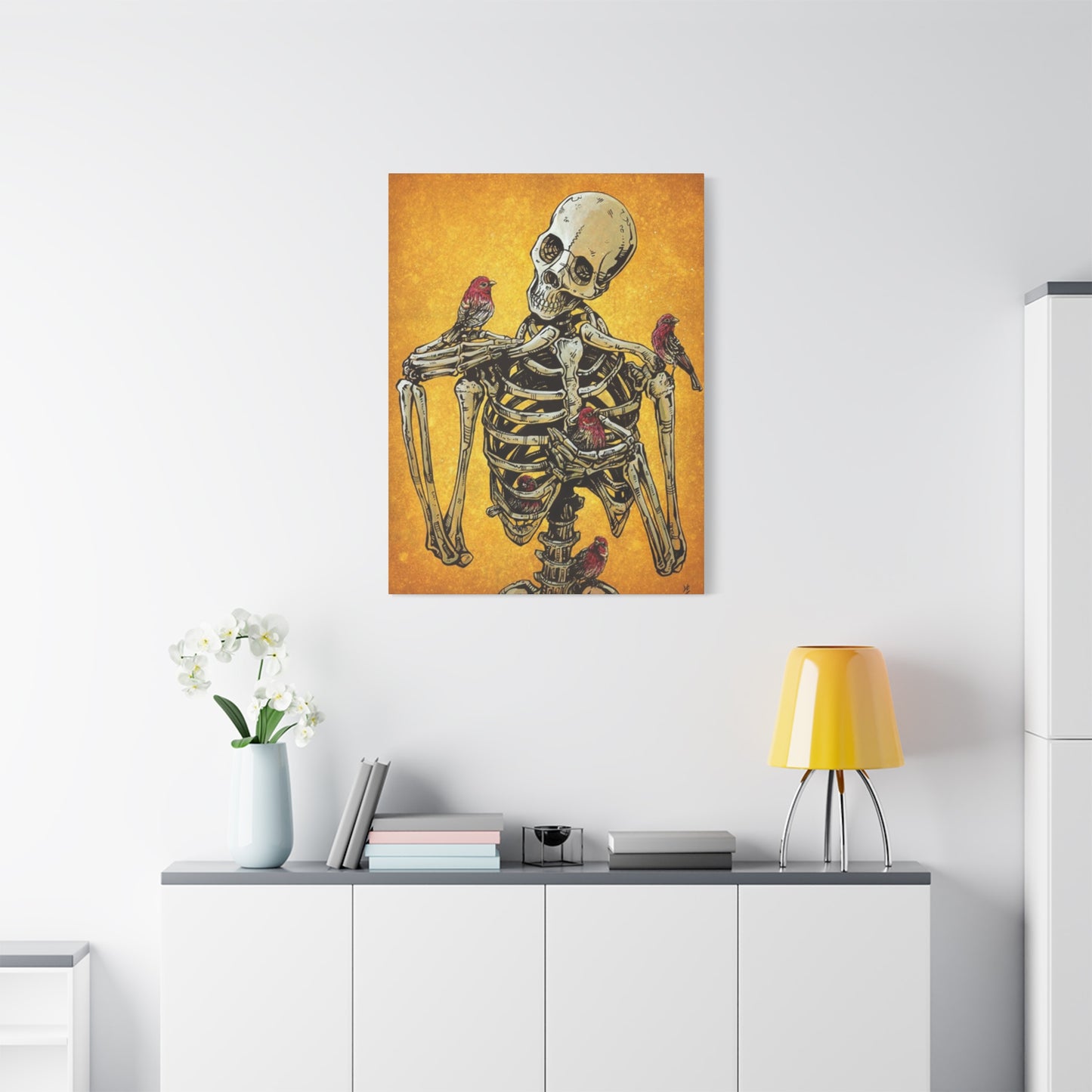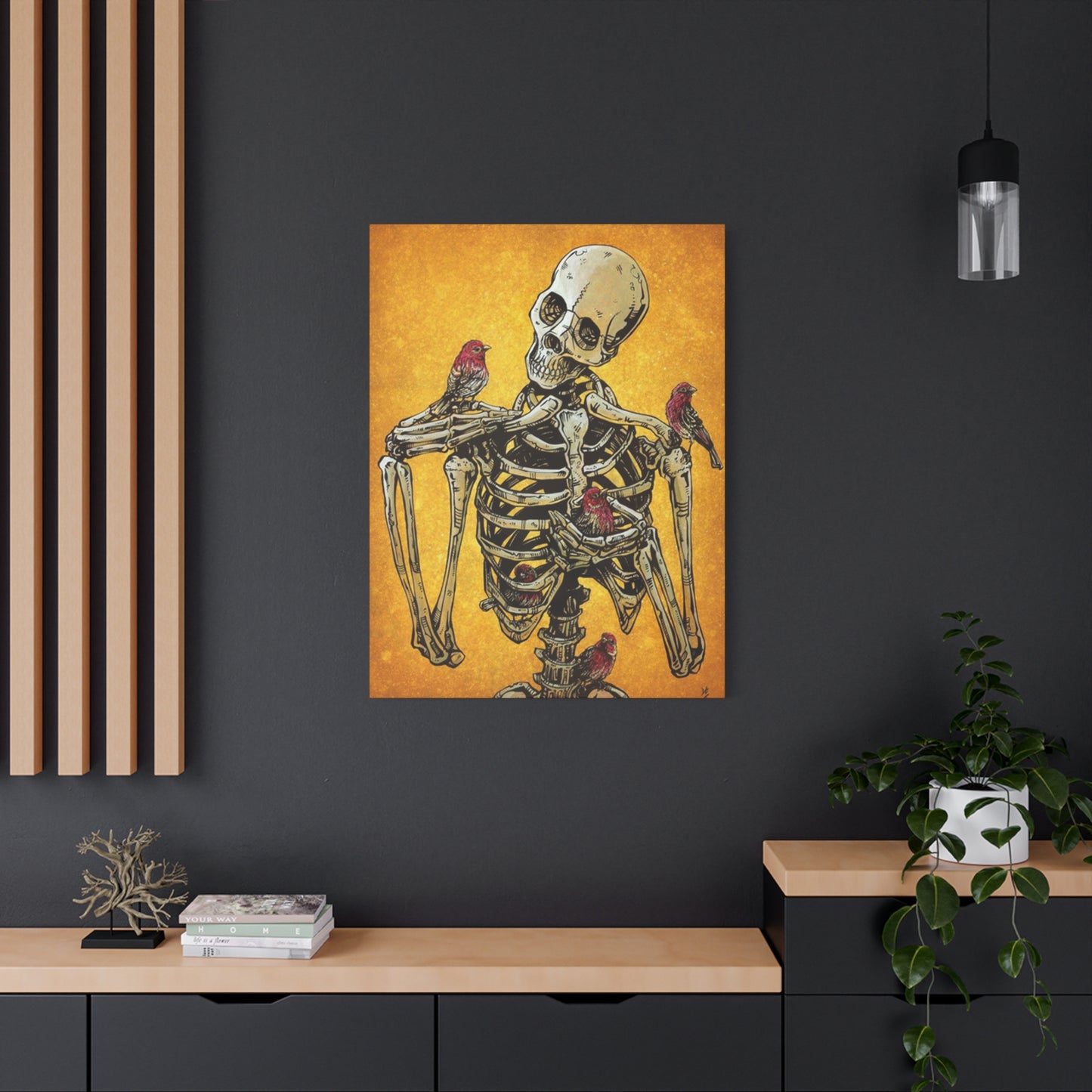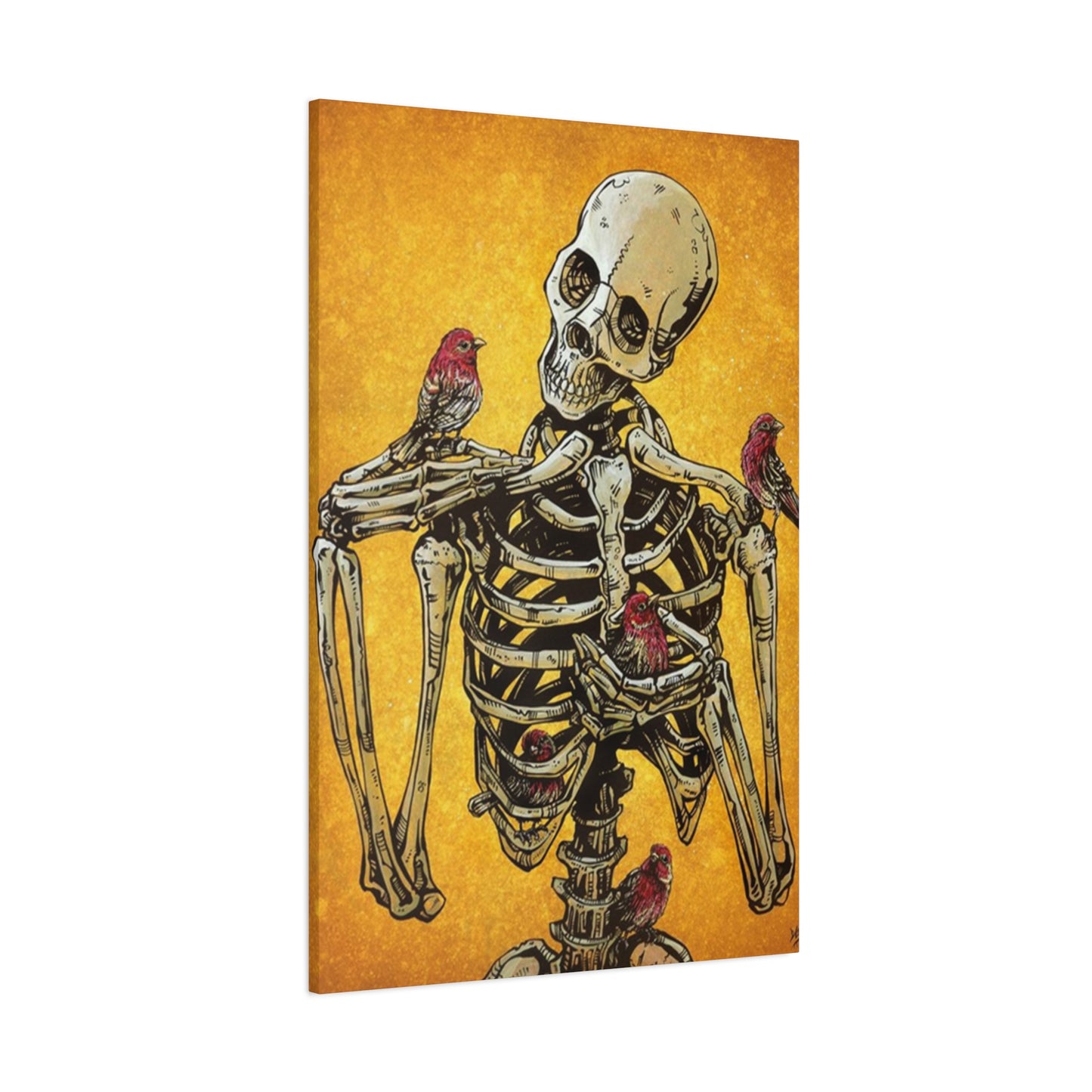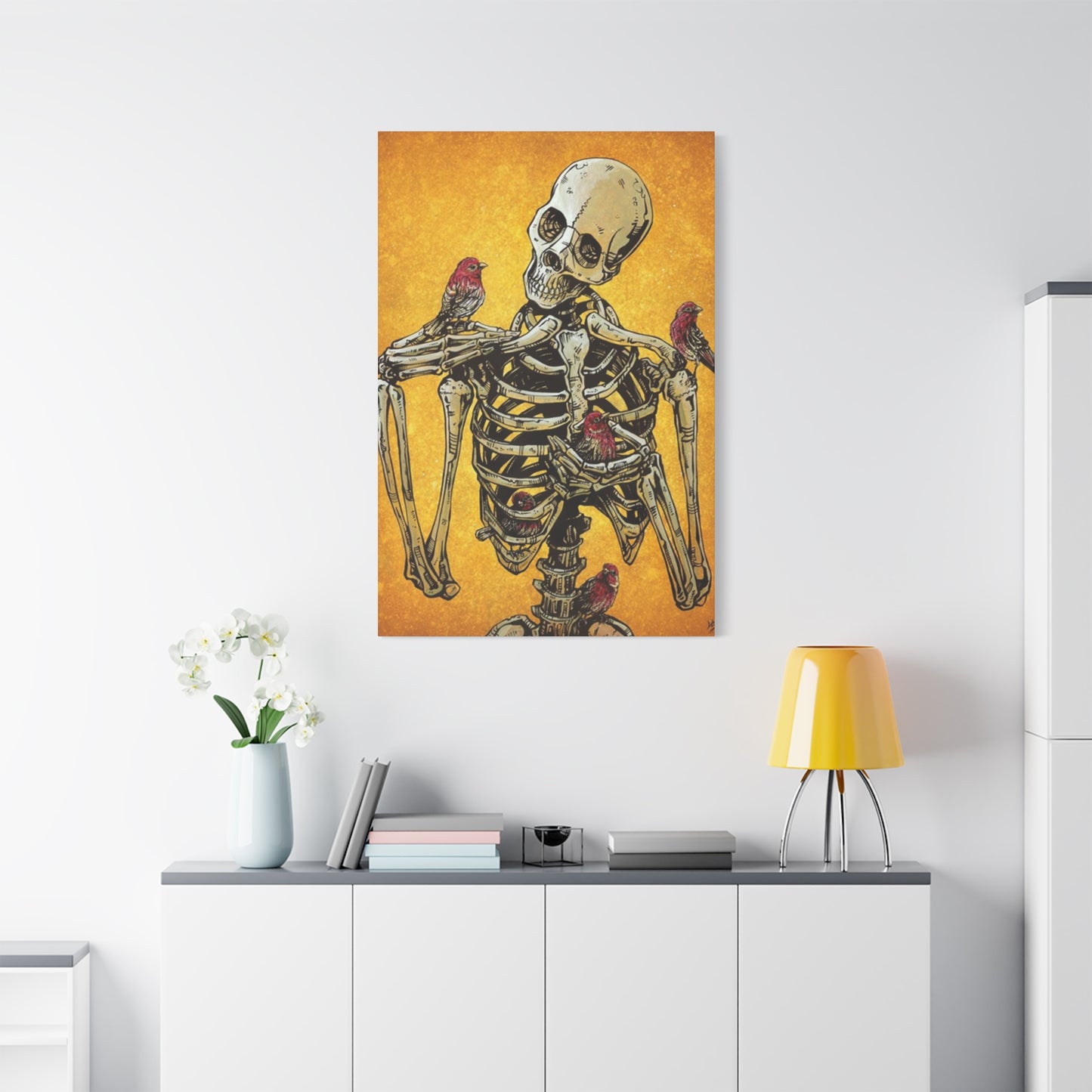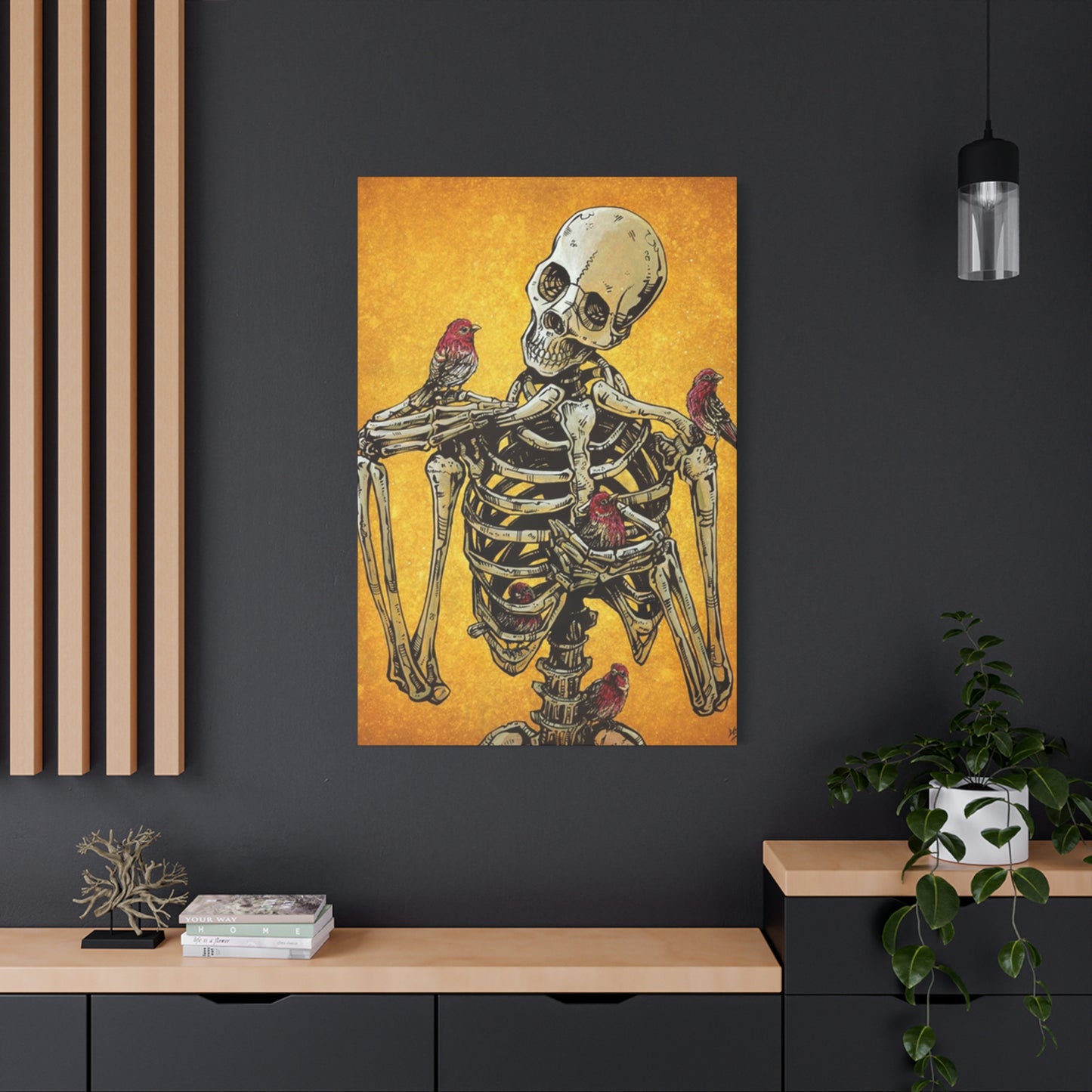Macabre Avian Skeletal Wall Art: Exploring Dark Gothic Bird and Bone Art Collections
The fascinating world of dark artwork featuring skeletal remains paired with avian imagery has captured the imagination of art enthusiasts, interior designers, and collectors who appreciate the profound symbolism and striking visual impact of these haunting compositions. This unique artistic genre combines the mystique of mortality with the freedom and beauty of flight, creating powerful visual narratives that speak to the human condition and our relationship with life, death, and transformation.
Gothic art featuring birds perched on or interacting with skeletal structures represents more than mere decoration; it embodies deep philosophical concepts about existence, the cycle of life, and the eternal dance between creation and destruction. These pieces serve as compelling conversation starters while adding sophisticated darkness to contemporary living spaces, offices, and galleries.
The popularity of macabre bird and skeleton artwork has surged in recent years, driven by growing appreciation for alternative aesthetics, gothic home décor trends, and the increasing acceptance of darker artistic themes in mainstream interior design. From minimalist modern interpretations to elaborate traditional gothic representations, this art form offers endless possibilities for personal expression and atmospheric enhancement.
Artists working in this genre draw inspiration from various sources, including Victorian mourning art, Day of the Dead traditions, anatomical studies, ornithological illustrations, and contemporary street art movements. The result is a rich tapestry of styles and interpretations that cater to diverse tastes while maintaining the core elements that make these pieces so captivating and emotionally resonant.
Skeletal Foundation with Avian Companions in Contemporary Wall Decoration
The art of displaying skeletal structures adorned with bird imagery has evolved into a sophisticated form of wall decoration that appeals to those seeking to create atmospheric and thought-provoking interior spaces. These compositions typically feature detailed anatomical representations of human or animal skeletons serving as perches, nests, or interactive environments for various bird species, creating a harmonious yet unsettling juxtaposition that challenges viewers' perceptions of beauty and mortality.
Contemporary artists approach this subject matter with remarkable creativity, employing diverse techniques ranging from photorealistic digital artwork to abstract expressionist interpretations. The skeletal elements are often rendered with scientific precision, showcasing the intricate architecture of bone structures while maintaining artistic sensitivity that prevents the imagery from becoming purely clinical or disturbing. Birds are frequently depicted in naturalistic poses, suggesting movement, contemplation, or protective behavior that adds emotional depth to the overall composition.
The color palettes employed in these works vary dramatically, from monochromatic schemes that emphasize form and shadow to rich, saturated tones that highlight specific elements within the composition. Many artists favor muted earth tones, deep blacks, and warm grays that create a sense of age and mystery, while others incorporate unexpected pops of color through the birds' plumage or environmental elements that suggest life persisting in the face of mortality.
Texture plays a crucial role in the success of these artworks, with artists employing various techniques to convey the smooth hardness of bone, the delicate softness of feathers, and the weathered surfaces that suggest the passage of time. Digital artists often simulate traditional media effects, while traditional painters may incorporate mixed media elements to achieve desired textural contrasts that enhance the overall impact of their work.
The symbolic significance of combining skeletal imagery with birds extends beyond mere aesthetic appeal, touching on universal themes of transformation, freedom, and the continuity of life cycles. Birds have long been associated with souls, messages from beyond, and the connection between earthly and spiritual realms, making their pairing with skeletal remains particularly powerful from both visual and conceptual standpoints.
Avian Mortality Themes in Poster Art Collections
Poster art featuring birds and skeletal imagery has become increasingly popular among collectors and interior design enthusiasts who appreciate the accessibility and versatility of this format. Unlike original paintings or sculptures, poster prints offer affordable entry points into the world of dark avian art while maintaining high-quality reproduction standards that preserve the impact and detail of original compositions.
The poster format lends itself particularly well to series collections, allowing artists to explore variations on themes, different bird species, or seasonal interpretations of mortality symbolism. Many artists create cohesive sets that can be displayed together to create gallery walls or distributed throughout a space to maintain thematic continuity while avoiding visual overwhelm. These collections often feature recurring skeletal elements paired with different avian subjects, creating narrative threads that reward careful observation and contemplation.
Commercial poster production has enabled wider distribution of works by emerging artists who might otherwise struggle to reach audiences interested in this specialized genre. Print-on-demand technology has revolutionized the availability of unique designs, allowing artists to experiment with niche concepts while building dedicated followings among collectors who appreciate the combination of accessibility and artistic quality that modern poster production provides.
The durability and presentation options available for contemporary poster art have eliminated many traditional concerns about longevity and professional appearance. High-quality printing materials and techniques ensure that poster reproductions maintain color accuracy and detail retention over time, while professional framing options allow these works to achieve visual impact comparable to more expensive original pieces when properly displayed.
Many poster collections in this genre feature educational elements that enhance their appeal to viewers interested in both artistic and scientific aspects of the subject matter. Anatomical accuracy in skeletal representations combined with ornithologically correct bird depictions creates pieces that serve dual purposes as decoration and informal educational tools, particularly appealing to those with interests in natural history, medical fields, or biological sciences.
The international appeal of bird and skeleton poster art has led to diverse cultural interpretations of these themes, with artists from different regions incorporating local avian species, traditional artistic techniques, and cultural symbolism that adds layers of meaning to familiar compositional frameworks. This global perspective enriches the genre while maintaining its core appeal to universal human experiences and emotions.
Gothic Avian Imagery on Skeletal Canvas Compositions
Canvas artwork featuring gothic interpretations of birds interacting with skeletal elements represents some of the most sophisticated and emotionally resonant pieces in this artistic category. The texture and depth possible with canvas-based media allow artists to create works with remarkable visual impact and lasting appeal that elevate these pieces beyond simple decorative function into the realm of serious artistic expression.
Gothic styling in avian skeletal artwork draws heavily from historical art movements while incorporating contemporary sensibilities and techniques. Traditional gothic elements such as pointed arches, ornate detailing, and dramatic lighting effects are often integrated with the primary subjects to create cohesive compositions that honor artistic heritage while remaining relevant to modern aesthetic preferences. The result is artwork that feels both timeless and contemporary, appealing to viewers with diverse artistic backgrounds and preferences.
The scale possibilities offered by canvas formats enable artists to create pieces ranging from intimate studies suitable for personal spaces to large-scale works capable of commanding attention in commercial or gallery settings. Larger canvases allow for greater detail in both skeletal and avian elements, while smaller works often focus on emotional intensity and symbolic content that creates powerful impact despite compact dimensions.
Color relationships in gothic avian canvas work require careful consideration to maintain the atmospheric qualities essential to the genre while ensuring visual interest and emotional engagement. Many successful pieces employ limited color palettes that emphasize contrast and mood over naturalistic representation, using color strategically to guide viewers' attention and enhance the symbolic content of the composition.
The interplay between realistic anatomical rendering and stylistic interpretation creates opportunities for artists to demonstrate technical skill while exploring creative expression. The most compelling pieces in this category successfully balance scientific accuracy with artistic vision, creating works that satisfy viewers seeking both educational content and aesthetic pleasure. This balance is particularly important when depicting skeletal structures, which must maintain anatomical credibility to avoid appearing cartoonish or unconvincing.
Environmental elements within gothic avian canvas compositions often include architectural features, landscape elements, or atmospheric effects that enhance the overall mood while providing context for the primary subjects. These supporting elements require careful integration to avoid overwhelming the central imagery while contributing meaningfully to the overall narrative and emotional impact of the piece.
Avian Skull Mounted Bone Structure Wall Art Displays
The artistic representation of birds positioned on or around skull-mounted skeletal structures creates some of the most striking and symbolically rich imagery in the dark art genre. These compositions typically focus on the relationship between death and life, permanence and transience, while exploring themes of memory, legacy, and the continuation of natural cycles through powerful visual metaphors that resonate with viewers on multiple levels.
Skull imagery carries particularly potent symbolic weight across numerous cultures and artistic traditions, serving as universal reminders of mortality while simultaneously representing transformation, wisdom, and the essential nature of existence beneath superficial appearances. When combined with avian subjects, skulls become platforms for exploring concepts of soul, spirit, and the transcendence of physical limitations through flight and freedom.
The technical challenges involved in accurately depicting skull structures while maintaining artistic appeal require significant skill and understanding of both anatomy and compositional principles. Successful pieces balance scientific accuracy with aesthetic considerations, ensuring that skeletal elements remain recognizable and credible while serving the overall artistic vision. This balance is particularly crucial when working with human skull imagery, which must be handled with appropriate sensitivity and respect.
Bird positioning relative to skull elements offers numerous compositional possibilities, from perching arrangements that suggest rest or contemplation to dynamic poses that imply movement or interaction. The most effective pieces create visual relationships between avian and skeletal subjects that suggest narrative content without becoming overly literal or heavy-handed in their symbolism. These subtle interactions allow viewers to develop their own interpretations while remaining engaged with the artwork's emotional content.
Lighting effects play crucial roles in skull and bird compositions, with dramatic shadows and highlights creating depth, mood, and visual interest that enhance the overall impact of the piece. Many artists employ chiaroscuro techniques that emphasize the contrast between light and dark elements, creating theatrical effects that complement the inherent drama of the subject matter while maintaining artistic sophistication and technical excellence.
The cultural sensitivity required when working with skull imagery necessitates careful consideration of intended audiences and display contexts. While these pieces can create powerful artistic statements, they must be created and presented with awareness of diverse cultural perspectives on mortality symbolism and respect for varying comfort levels with explicit death imagery.
Corvid Species with Skeletal Framework Canvas Print Art
Crows, ravens, and other corvid species have long held special significance in mythologies, folklore, and artistic traditions worldwide, making them particularly compelling subjects for skeletal framework artwork. These intelligent birds carry rich symbolic associations with wisdom, prophecy, death, and transformation that enhance the conceptual depth of pieces featuring them alongside skeletal elements, creating artwork with multiple layers of meaning and cultural resonance.
The distinctive silhouettes and behaviors of corvids provide artists with recognizable subjects that viewers can easily identify and relate to their own experiences with these remarkable birds. Crows and ravens possess natural grace and dignity that translates beautifully to artistic representation, while their black plumage creates striking contrasts against lighter skeletal elements and allows for sophisticated explorations of value, texture, and form within monochromatic or limited color schemes.
Corvid intelligence and social behaviors offer rich source material for artists seeking to create pieces with narrative content or emotional depth. These birds are known for their complex relationships with death, including their curious investigations of carcasses and their apparent mourning rituals, making their pairing with skeletal imagery particularly appropriate and symbolically resonant for viewers familiar with corvid natural history.
The size and proportional relationships between corvids and various skeletal structures provide excellent compositional opportunities, as these birds are large enough to create significant visual impact while remaining appropriately scaled relative to human or animal skeletal remains. This size compatibility allows artists to create believable interactions between avian and skeletal subjects without resorting to dramatic scale adjustments that might compromise the credibility of their compositions.
Canvas print reproductions of corvid and skeleton artwork offer collectors opportunities to own high-quality representations of pieces that might otherwise be financially or practically inaccessible. Modern printing technologies preserve the subtle tonal variations and textural details that make these works compelling, while canvas substrates provide appropriate weight and presence that enhance the viewing experience and ensure professional presentation quality.
The versatility of corvid and skeleton imagery makes these pieces suitable for diverse interior design contexts, from traditional gothic décor schemes to contemporary minimalist environments where their stark beauty can create focal points without overwhelming existing design elements. The timeless quality of both corvid and skeletal subjects ensures that these pieces remain relevant and appealing across changing design trends and personal aesthetic evolution.
Skeletal Remains with Avian Subject Poster Collections
Poster collections featuring skeletal remains paired with various avian subjects provide accessible entry points into dark art appreciation while offering flexibility and variety that appeals to collectors with diverse interests and display preferences. These collections often explore different aspects of the central theme through variations in bird species, skeletal types, compositional approaches, or artistic styles that create cohesive yet diverse viewing experiences.
The educational value inherent in accurately depicted skeletal and avian anatomy makes these poster collections particularly appealing to viewers with scientific interests or educational applications. Many pieces successfully balance artistic vision with anatomical accuracy, creating works that serve dual purposes as decorative art and informal learning tools that can enhance understanding of natural history, comparative anatomy, or ornithological studies.
Seasonal variations within poster collections allow artists to explore temporal themes while maintaining conceptual consistency across multiple pieces. Spring compositions might emphasize new life emerging from or around skeletal remains, while autumn pieces could focus on decay, migration, or preparation for winter dormancy. These seasonal interpretations add depth and variety to collections while providing options for rotating displays that reflect changing natural cycles.
The affordability and accessibility of poster collections democratize access to specialized art genres that might otherwise remain limited to collectors with significant financial resources. This accessibility has contributed to growing interest in dark art themes and has enabled emerging artists to build audiences and develop their skills while exploring niche subjects that might not support traditional gallery representation.
International shipping and digital distribution capabilities have created global markets for specialized poster collections, allowing artists to reach audiences worldwide while enabling collectors to access works by artists from diverse cultural backgrounds and artistic traditions. This global reach has enriched the genre through cross-cultural pollination of ideas, techniques, and symbolic interpretations that enhance the overall diversity and quality of available works.
The curatorial possibilities offered by poster collections encourage active engagement between collectors and their chosen pieces, as the ability to easily change, rearrange, or supplement displays allows for ongoing evolution of living spaces that reflect changing moods, seasons, or personal growth. This flexibility makes poster collections particularly suitable for renters or others who prefer adaptable décor solutions.
Dark Aesthetic Bird on Bone Structure Canvas Art
The dark aesthetic movement in contemporary art has embraced bird and bone structure imagery as powerful vehicles for exploring themes of beauty, decay, mortality, and transformation through visually striking compositions that challenge conventional notions of decorative art. These pieces often employ sophisticated color palettes, dramatic lighting effects, and complex symbolic layering that creates artwork with significant emotional impact and lasting appeal for viewers who appreciate depth and complexity in their chosen pieces.
Contemporary dark aesthetic interpretations frequently incorporate elements from multiple artistic movements, including romanticism, surrealism, gothic revival, and modern minimalism, creating hybrid approaches that feel both familiar and innovative. This synthesis of influences allows artists to create works that honor artistic heritage while remaining relevant to contemporary audiences and current aesthetic preferences, ensuring broad appeal across diverse viewer demographics.
The psychological impact of dark aesthetic bird and bone artwork often extends beyond immediate visual impression to create lasting emotional resonance that enhances the viewing experience over time. These pieces can serve as meditation focuses, conversation starters, or simply atmospheric enhancers that contribute to desired moods or feelings within living or working spaces. The ability to create these lasting impressions distinguishes successful dark aesthetic pieces from mere decorative objects.
Canvas formats provide ideal substrates for dark aesthetic works, as the texture and depth possible with canvas-based media enhance the atmospheric qualities essential to this artistic approach. The ability to build layers of paint, create textural variations, and achieve subtle tonal transitions contributes significantly to the overall impact of pieces that rely on mood and atmosphere as primary means of viewer engagement and emotional connection.
The versatility of dark aesthetic approaches allows for wide variation in scale, style, and intensity while maintaining thematic coherence that makes these pieces suitable for diverse applications and settings. From subtle, contemplative pieces appropriate for private spaces to bold, dramatic works capable of commanding attention in public environments, dark aesthetic bird and bone art offers options for virtually any context or preference.
The growing acceptance of alternative aesthetic approaches in mainstream interior design has created new opportunities for dark aesthetic artwork to find appreciative audiences beyond traditional gothic or alternative culture demographics. This broader acceptance has encouraged artists to explore more nuanced approaches that maintain the essential characteristics of dark aesthetic work while appealing to viewers who might previously have avoided such themes or imagery.
Raven Imagery with Human Skeletal Elements Wall Art
Ravens hold particular fascination for artists and viewers interested in the intersection of avian beauty and mortality symbolism, as these remarkable birds have served as psychopomps, messengers between worlds, and symbols of wisdom and transformation across numerous cultural traditions. Their imposing presence and distinctive characteristics make them ideal subjects for combination with human skeletal elements in artwork that explores profound themes of existence, knowledge, and the relationship between life and death.
The cultural significance of ravens extends far beyond their biological characteristics to encompass rich mythological and literary associations that add layers of meaning to artistic representations. From Norse mythology's Huginn and Muninn to Edgar Allan Poe's literary masterpiece, ravens carry symbolic weight that enhances the conceptual depth of any artwork featuring them, particularly when combined with human skeletal imagery that reinforces themes of mortality and wisdom.
The physical characteristics of ravens provide artists with excellent subject matter for detailed realistic representation or stylistic interpretation. Their glossy black plumage offers opportunities for sophisticated explorations of light, shadow, and reflection, while their intelligent expressions and dignified postures create emotional connections with viewers that enhance the overall impact of pieces featuring them alongside human skeletal remains.
The proportional relationships between ravens and human skeletal structures create natural compositional opportunities that feel believable and visually satisfying without requiring dramatic scale adjustments or artistic liberties that might compromise the credibility of the overall composition. This natural compatibility allows artists to focus on emotional content and symbolic meaning rather than technical challenges related to scale or anatomical accuracy.
Human skeletal elements in raven-themed artwork require particularly sensitive handling to ensure appropriate respect for mortality themes while maintaining artistic integrity and viewer engagement. The most successful pieces balance the inherent solemnity of human remains with the vital energy and intelligence associated with ravens, creating compositions that honor both elements while exploring their symbolic relationships in meaningful ways.
The market appeal of raven and human skeleton artwork extends beyond traditional gothic or dark art enthusiasts to include collectors interested in literary themes, mythology, natural history, or simply striking black and white compositions that can enhance diverse interior design schemes. This broad appeal has contributed to the popularity of this particular subject combination and has encouraged artists to continue exploring variations and new interpretations of these timeless themes.
Gothic Bird Perched on Bone Structure Decorative Art
Gothic decorative art featuring birds perched on various bone structures represents a sophisticated fusion of natural history accuracy and artistic interpretation that creates pieces with both educational value and significant aesthetic appeal. These compositions typically emphasize the architectural qualities of skeletal frameworks while showcasing the grace and beauty of avian subjects in contemplative or active poses that suggest narrative content without becoming overly literal or sentimental.
The architectural elements inherent in gothic artistic traditions complement the natural architecture of skeletal structures, creating opportunities for artists to explore formal relationships between constructed and biological design principles. Gothic arches, flying buttresses, and ornate detailing find echoes in the curves, connections, and decorative elements of natural bone structures, allowing for seamless integration of artistic and anatomical elements within single compositions.
Perching behaviors offer artists numerous options for depicting birds in natural, believable poses that enhance the overall credibility of their compositions while providing opportunities for dynamic visual interest and emotional engagement. From alert, watchful positions to relaxed, resting postures, different perching attitudes can significantly influence the mood and symbolic content of finished pieces, allowing artists to fine-tune the emotional impact of their work.
The decorative applications of gothic bird and bone art have expanded significantly as interior design trends have embraced alternative aesthetic approaches and historical revival elements. These pieces can serve as sophisticated focal points in traditional or contemporary settings, providing visual interest and conversation-starting potential while demonstrating artistic appreciation and cultural awareness that reflects well on collectors and displayers.
Color choices in gothic bird and bone decorative art often emphasize earth tones, metallics, and muted palettes that complement traditional decorative schemes while avoiding overly bright or contemporary colors that might clash with period furniture or architectural elements. This color sensitivity ensures that pieces integrate successfully with existing décor while maintaining their essential character and artistic integrity.
The craftsmanship standards expected in decorative art applications require particular attention to finish quality, color accuracy, and long-term durability that ensure pieces maintain their appearance and impact over extended display periods. Professional-quality printing, appropriate substrate selection, and proper framing or mounting techniques are essential for achieving the presentation standards expected in decorative applications where appearance and longevity are paramount considerations.
Skeletal Framework with Multiple Bird Species Illustration Prints
Illustration prints featuring skeletal frameworks populated by multiple bird species create opportunities for complex compositional arrangements that explore biodiversity, ecological relationships, and the universal themes of mortality and renewal through diverse avian representations. These multi-species compositions often serve as celebrations of ornithological diversity while maintaining thematic coherence through shared skeletal elements that provide structural unity and symbolic consistency.
The educational potential of multi-species skeletal framework illustrations extends beyond artistic appreciation to encompass comparative anatomy, ornithological studies, and ecological understanding that makes these pieces particularly valuable for educational institutions, nature centers, or collectors with scientific interests. Accurate species representation combined with anatomically correct skeletal elements creates works that can enhance understanding while providing aesthetic pleasure and decorative value.
Compositional challenges inherent in multi-species arrangements require careful planning and skilled execution to achieve visual balance while ensuring that individual species receive appropriate attention and recognition. Successful pieces create hierarchies of visual importance that guide viewers through the composition while allowing each species to contribute meaningfully to the overall design and thematic content of the finished work.
The diversity of bird species available for artistic representation provides virtually unlimited possibilities for creating unique combinations that reflect specific geographic regions, habitat types, or ecological relationships. Artists may choose to focus on local species familiar to their intended audiences or explore exotic species that introduce viewers to unfamiliar avian beauty while maintaining the universal appeal of skeletal framework compositions.
Seasonal migration patterns and behavioral differences among species offer additional layers of meaning and compositional possibility within multi-species skeletal framework illustrations. Some pieces may explore temporal themes by depicting species associated with different seasons, while others might focus on behavioral contrasts between predatory and prey species, social and solitary birds, or resident and migratory populations.
The print format provides cost-effective access to complex multi-species compositions that would be prohibitively expensive as original artworks while maintaining sufficient detail and color accuracy to preserve the educational and aesthetic value of detailed species representation. This accessibility has contributed to the popularity of multi-species illustrations among educators, naturalists, and collectors who appreciate both artistic quality and ornithological accuracy.
Painted Bird on Skeletal Structure Canvas Artwork
Traditional painting techniques applied to bird and skeletal structure subjects create opportunities for artistic expression that digital media cannot fully replicate, offering texture, depth, and spontaneity that enhance the emotional impact and aesthetic appeal of these compelling compositions. Painted works demonstrate artistic skill and commitment that collectors often find particularly appealing, as they represent unique, irreproducible artistic expressions that cannot be exactly duplicated through technological means.
The versatility of painting media allows artists to explore various approaches to bird and skeleton subjects, from photorealistic representations that emphasize technical skill to loose, expressive interpretations that prioritize emotional content and artistic vision over literal accuracy. This range of possibilities ensures that painted works can appeal to diverse aesthetic preferences while maintaining thematic consistency within the broader category of bird and skeleton art.
Color mixing and application techniques in painted bird and skeleton artwork require particular skill to achieve the subtle tonal variations essential for convincing representation of both organic and skeletal elements. The translucency of bone, the iridescence of feathers, and the various textural qualities of different materials challenge artists to demonstrate mastery of their chosen media while creating works with visual impact and lasting appeal.
The investment value of original painted artwork often exceeds that of printed reproductions, making these pieces particularly attractive to collectors who appreciate both aesthetic qualities and potential financial appreciation. The uniqueness and irreproducibility of painted works contribute to their collectible status while ensuring that owners possess genuinely exclusive pieces that cannot be exactly replicated or mass-produced.
Canvas substrates provide ideal foundations for painted bird and skeleton artwork, offering texture and absorbency that enhance paint application while providing appropriate weight and presence for serious artistic works. The archival qualities of professional-grade canvas and paint systems ensure that properly executed works maintain their appearance and value over extended periods, making them suitable for long-term collecting and display.
The intimate connection between artist and subject matter evident in painted works often creates emotional resonance that enhances the viewing experience beyond what might be achieved through mechanical reproduction processes. This human touch and artistic interpretation adds value and meaning that sophisticated viewers often find particularly compelling and worthy of investment in time, money, and emotional engagement.
Bird Skull Combined with Skeletal Art Poster Presentations
Poster presentations featuring bird skulls combined with broader skeletal elements create educational and artistic opportunities that appeal to audiences interested in comparative anatomy, natural history, and the intersection of science and art. These specialized works often emphasize the remarkable diversity and adaptation evident in avian skull structures while placing them within larger contexts that enhance understanding and appreciation of biological design principles.
The delicate beauty and functional efficiency of bird skulls provide compelling subject matter for detailed artistic representation that can serve both decorative and educational purposes. The hollow bones, specialized beak structures, and optical adaptations visible in bird skulls demonstrate evolutionary refinement that artists can explore through various representational approaches, from scientific illustration techniques to more interpretive artistic treatments.
Comparative presentations featuring multiple bird skull types alongside other skeletal elements create opportunities for exploring evolutionary relationships, dietary adaptations, and environmental specializations that make these pieces particularly valuable for educational applications. Museums, nature centers, and educational institutions often find such works useful for enhancing displays and providing visual aids that support learning objectives while maintaining aesthetic appeal.
The accessibility and affordability of poster formats make complex anatomical presentations available to audiences who might not otherwise have access to original scientific illustrations or expensive educational materials. This democratization of scientific art has contributed to growing public interest in natural history subjects while supporting artists who specialize in accurate biological representation and scientific illustration techniques.
Professional presentation standards for scientific and educational poster art require particular attention to accuracy, clarity, and informational content that distinguishes these works from purely decorative pieces. Successful educational posters balance artistic appeal with scientific accuracy, ensuring that viewers receive correct information while enjoying aesthetically pleasing presentations that encourage continued interest and engagement with the subject matter.
The durability requirements for educational poster applications often exceed those for decorative uses, as these pieces may experience frequent handling, changing lighting conditions, and extended display periods that demand superior materials and construction techniques. Professional-quality printing and substrate selection are essential for achieving the longevity expected in educational and institutional applications where appearance and informational accuracy must be maintained over time.
Modern Interpretations of Bird on Skeletal Structure Wall Décor
Contemporary artists approaching bird and skeletal structure themes bring fresh perspectives and innovative techniques to traditional subject matter, creating modern interpretations that honor artistic heritage while remaining relevant to current aesthetic preferences and cultural sensibilities. These modern approaches often incorporate elements from various artistic movements, technological innovations, and cross-cultural influences that expand the possibilities for creative expression within established thematic frameworks.
Minimalist approaches to bird and skeleton imagery focus on essential elements and simplified compositions that achieve maximum impact through careful editing and refined execution rather than complex detail or elaborate ornamentation. These contemporary interpretations often appeal to viewers who appreciate sophisticated simplicity and understated elegance while remaining engaged with the fundamental themes and symbolic content that make this subject matter compelling across diverse artistic treatments.
Digital art techniques and hybrid media approaches allow contemporary artists to explore effects and combinations impossible through traditional methods alone, creating works that bridge historical artistic traditions and cutting-edge technological capabilities. These innovations have expanded the visual vocabulary available to artists while providing new tools for exploring established themes in fresh and exciting ways that can attract new audiences to traditional subject matter.
The integration of contemporary color theories, compositional principles, and design elements creates modern bird and skeleton art that fits seamlessly into contemporary interior design schemes while maintaining the essential character and symbolic content that defines this artistic category. This balance between innovation and tradition ensures broad appeal while preserving the meaningful content that gives these works lasting significance beyond mere decorative function.
Environmental consciousness and sustainability concerns have influenced modern approaches to bird and skeleton art, with many contemporary artists incorporating themes related to extinction, habitat loss, and environmental degradation that add urgency and relevance to traditional mortality symbolism. These contemporary concerns create opportunities for meaningful dialogue about current issues while maintaining connection to timeless themes of life, death, and transformation.
The global reach of contemporary art markets has enabled cross-cultural pollination of ideas and techniques that enrich modern interpretations of bird and skeleton themes through diverse cultural perspectives and artistic traditions. This international influence has created hybrid approaches that combine elements from various traditions while creating new possibilities for artistic expression that transcend geographic and cultural boundaries.
Black Bird Species with Bone Structure Wall Art Collections
Black bird species, including crows, ravens, blackbirds, and grackles, provide particularly striking subjects for bone structure wall art due to their dramatic silhouettes, symbolic associations, and natural elegance that creates powerful visual impact when combined with skeletal elements. The monochromatic palette possibilities offered by black birds allow for sophisticated explorations of value, texture, and form that can achieve remarkable depth and complexity without relying on color variation or distraction.
The cultural significance of black birds extends across numerous traditions and belief systems, encompassing associations with mystery, wisdom, prophecy, and transformation that enhance the symbolic content of artwork featuring them alongside bone structures. These rich cultural connections provide layers of meaning that reward contemplation while creating conversation-starting potential that extends beyond immediate visual impact to encompass broader philosophical and spiritual themes.
The variety of black bird species available for artistic representation ensures that collections can explore diverse body types, beak shapes, proportional relationships, and behavioral characteristics while maintaining color consistency that creates visual coherence across multiple pieces. This diversity within unity provides excellent foundation for series development and collection building that can evolve over time while maintaining thematic consistency and aesthetic appeal.
Professional photography and digital art techniques have enabled increasingly sophisticated representation of black bird plumage textures, highlighting the subtle variations and iridescent qualities that distinguish different species while creating visually rich surfaces that complement the smooth, hard qualities of bone structures. These textural contrasts add visual interest and tactile appeal that enhance the overall viewing experience.
The dramatic lighting possibilities offered by black bird subjects create opportunities for exploring chiaroscuro effects, rim lighting, and shadow play that can add theatrical impact and emotional depth to bone structure compositions. These lighting effects often prove crucial for creating the atmospheric qualities that distinguish memorable artwork from simple representational pieces.
Market demand for black bird and bone structure wall art has grown significantly as interior design trends have embraced monochromatic schemes, natural history themes, and alternative aesthetic approaches that value sophistication over conventional prettiness. This growing acceptance has created opportunities for artists and collectors while ensuring continued development and refinement of this specialized artistic category.
Artistic Bird on Skeletal Framework Canvas Print Collections
Artistic interpretations of birds positioned on or interacting with skeletal frameworks represent some of the most creative and emotionally resonant works in this genre, as artists explore the tension between scientific accuracy and creative expression while developing unique visual languages that distinguish their work from purely representational approaches. These artistic collections often feature consistent stylistic approaches applied to various subject combinations, creating recognizable artistic voices while exploring diverse aspects of the central theme.
The balance between anatomical accuracy and artistic license requires careful consideration to maintain credibility while allowing for creative expression that elevates these works beyond simple scientific illustration into the realm of fine art. Successful artistic interpretations honor the essential characteristics of their subjects while incorporating stylistic elements that reflect individual artistic vision and contemporary aesthetic sensibilities.
Canvas print collections of artistic bird and skeleton work provide affordable access to sophisticated artistic interpretations while maintaining the visual impact and presentation quality essential for serious display applications. Modern printing technologies preserve subtle artistic details and color relationships that distinguish artistic works from more straightforward representational pieces, ensuring that reproductions maintain their essential character and emotional impact.
The collectibility of artistic bird and skeleton canvas prints has created secondary markets and investment opportunities for works by established artists while providing emerging artists with platforms for building recognition and developing their artistic careers. This market development has encouraged continued innovation and quality improvement within the category while ensuring diverse options for collectors with varying budgets and preferences.
Curatorial possibilities offered by artistic canvas print collections enable sophisticated display strategies that can enhance individual pieces while creating larger narratives or thematic explorations through careful selection and arrangement. These curatorial opportunities add value beyond individual pieces while creating opportunities for educational and interpretive content that can enhance appreciation and understanding.
The archival qualities and longevity of professional canvas prints ensure that artistic collections maintain their appearance and value over extended periods, making them suitable for long-term collecting strategies and institutional applications where durability and color stability are essential considerations. This reliability has contributed to growing acceptance of print collections as legitimate alternatives to original artwork for many applications and budgets.
Gothic Style Bird and Skeleton Wall Poster Art
Gothic style interpretations of bird and skeleton subjects draw from rich historical artistic traditions while incorporating contemporary sensibilities that create works appealing to both traditional gothic art enthusiasts and modern viewers who appreciate sophisticated alternative aesthetics. These poster art pieces often feature elaborate decorative elements, dramatic lighting effects, and symbolic content that connects them to broader gothic artistic movements while maintaining focus on avian and skeletal subjects.
Historical gothic art elements, including pointed arches, ornate tracery, and ecclesiastical symbolism, provide rich visual vocabularies for contemporary artists working with bird and skeleton themes. These traditional elements can be integrated subtly as background elements or featured prominently as primary compositional components, depending on the artist's vision and intended audience preferences.
The poster format provides excellent opportunities for gothic bird and skeleton art to reach audiences interested in alternative décor options without the expense associated with original gothic artwork or antique pieces. This accessibility has contributed to growing interest in gothic aesthetic approaches while supporting contemporary artists who work within historical traditions.
Color palettes typical of gothic style art often emphasize deep, rich tones and metallic accents that complement the natural colors of bird plumage and bone structures while creating atmospheric effects essential to gothic aesthetic success. These color choices require careful consideration to maintain period authenticity while ensuring contemporary appeal and compatibility with modern interior design schemes.
The symbolic content inherent in gothic artistic traditions aligns naturally with the themes explored through bird and skeleton imagery, creating opportunities for layered meaning and interpretive depth that rewards careful viewing and contemplation. These symbolic connections add intellectual and emotional content that distinguishes sophisticated gothic art from simple decorative pieces with gothic styling.
The growing popularity of gothic revival movements in interior design, fashion, and popular culture has created expanded markets for authentic gothic style artwork while encouraging artists to explore historical techniques and aesthetic principles that might otherwise be forgotten or neglected. This revival has benefited both artists and collectors while ensuring continued development and refinement of gothic artistic traditions.
Decorative Bird Perched on Bone Wall Art Displays
Decorative applications of bird and bone wall art require careful consideration of both aesthetic appeal and appropriateness for specific display contexts, as these pieces must successfully integrate with existing décor schemes while maintaining their essential character and symbolic content. Successful decorative pieces achieve this balance through sophisticated design choices that honor the subject matter while ensuring compatibility with diverse interior design approaches and personal preferences.
The versatility of bird and bone imagery allows for adaptation to various decorative styles, from traditional and classic approaches to contemporary and modern interpretations that can enhance diverse living and working spaces. This adaptability has contributed to the growing popularity of these themes among interior designers and homeowners who appreciate unique decorative options that offer depth and meaning beyond simple visual appeal.
Professional presentation standards for decorative wall art require attention to framing, matting, and display techniques that enhance the artwork while ensuring appropriate protection and longevity. These presentation considerations often prove crucial for achieving the sophisticated appearance expected in decorative applications where visual impact and long-term durability are primary concerns.
The psychological impact of decorative bird and bone art extends beyond immediate visual impression to influence mood, atmosphere, and emotional tone within displayed spaces. These effects require careful consideration during selection and placement to ensure that chosen pieces contribute positively to desired environmental qualities while avoiding overwhelming or disturbing effects that might detract from the intended purpose of decorated spaces.
Seasonal adaptation possibilities allow decorative bird and bone art to remain fresh and interesting through rotating displays or seasonal accent pieces that complement permanent installations while providing variety and visual interest throughout the year. This flexibility makes these pieces particularly valuable for decorative applications where change and adaptation are desired or necessary.
The conversation-starting potential of decorative bird and bone art adds social value beyond aesthetic appeal, as these pieces often generate discussion and interest that enhances social interactions and demonstrates cultural awareness and artistic appreciation. This social benefit contributes to the overall value proposition of these decorative choices while ensuring continued interest and engagement over time.
Conclusion:
Macabre avian skeletal wall art offers a unique way to fuse dark aesthetics, natural history, and artistic intrigue into one captivating form of décor. These artworks combine the elegance of bird anatomy with gothic undertones, creating pieces that are both mysterious and thought-provoking. For collectors, gothic design enthusiasts, and lovers of unconventional beauty, skeletal bird art becomes more than just decoration—it transforms interiors into spaces that invite reflection, curiosity, and conversation.
The appeal of skeletal bird artwork lies in its ability to balance fragility with strength. The delicate structures of avian bones, when highlighted through artistic representation, emphasize both the transience of life and the timeless allure of nature. This duality resonates with gothic themes of mortality, beauty, and mystery, making these pieces powerful symbols as well as striking visual statements. Whether presented as minimalist sketches, detailed scientific illustrations, or stylized gothic prints, they embody depth and sophistication that extends far beyond typical wall décor.
From a design perspective, macabre avian wall art seamlessly complements interiors that lean toward gothic, industrial, or modern eclectic styles. Dark backgrounds, muted color palettes, and intricate detailing create a dramatic visual effect, while larger statement pieces can anchor rooms with bold character. Smaller framed artworks, on the other hand, can subtly enrich hallways, studies, or personal spaces with layers of narrative and symbolism.
Lighting plays a crucial role in amplifying the impact of these artworks. Soft, ambient lighting enhances the atmospheric qualities of skeletal designs, while directed spotlights can emphasize the fine lines and intricate bone details. When displayed strategically, these artworks evoke a gallery-like presence, transforming homes into curated spaces where art serves both aesthetic and philosophical purposes.
Symbolically, avian skeletal art carries a weight that resonates deeply with those drawn to gothic culture. Birds traditionally represent freedom, transcendence, and spiritual journeys, while skeletal imagery speaks to life’s impermanence and hidden truths. Combined, they create a compelling narrative that is both haunting and beautiful. For many, these artworks become personal reflections of inner complexity, making them not just décor but extensions of identity.

















